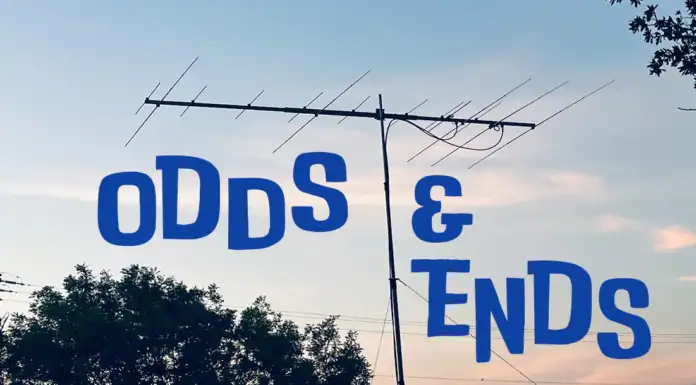I have been giving thought to setting up a six meter antenna with horizontal polarization. Plus, it would be nice if it were omnidirectional. I’d looked at a number of the loops and squared-off dipoles, even came close to buying a Delbert Loop at HamCom. Attending the Central States VHF Society Conference I caught a presentation where the speaker had set up all his antennas, complete with a rotator, in his attic. That was pretty impressive and got me to thinking about doing the same with a simple dipole.
The best thing about this approach is that it cost me next to nothing. I already had a Balun Designs 1:1 balun that was good to 54 MHz for the center insulator. I also had a length of Davis RF Bury Flex for the coax, some number 14 stranded wire, and two end insulators. I did have to expand the PVC pipe that comes out the eave of the house from the attic and then into my antenna input to the shack. But I already had the needed PVC as well.
I built the dipole and did some testing using my K3’s built-in SWR meter. Did some slight adjustments to the length and we’re now all set to compare the vertical dipole I’m currently using and the horizontal dipole in the attic. I do miss having an antenna analyser that works at VHF. That would have proven very helpful in tuning the frequency.
I did make a small attempt at adding omnidirectivity. The dipole, while being mostly horizontal, does have some slight bend to it that may help with rounding out the radiation pattern. My antenna modeling experience has shown that bending the dipole into a 90 degree angle readily provides 360 degrees of coverage. I wasn’t able to quite get that amount of angle but did work in some. We’ll see what happens on the air.
I’m also going to try out diversity reception on the K3 with vertical on one receiver, horizontal on the other. We’ll see if that makes any difference at VHF. The ARRL September VHF Contest is coming up and I’ll give this new antenna a real work out.
I’m now giving some thoughts to building a directional antenna. I already have the push-up mast, but need a rotator. This is a project for next time.
Dipole Calculators
Since 2014 this blog post has attracted a great deal of web traffic. Yet, as I look at it now, it appears to be missing genuine help in getting your dipole up and running.
My initial calculations were for each side of the dipole to be 4 feet 6 inches. Once installed, that didn’t quite reach resonance. Merely bending the eye-rings attached to the balun, lengthening the dipole slightly, brought it into resonance with 1.1 VSWR at 50.150 through 50.500 MHz. From this you can tell that things are very sensitive at these frequencies.
I also suggest you take a look at a few of the online dipole calculators. Here are two links:
http://www.csgnetwork.com/antennaedcalc.html
http://www.hamuniverse.com/dipivcal.html
I see that these calculators call for slightly longer dipole legs than what I used. I do like the second calculator’s estimates for an inverted vee.
If you want to get a bit more sophisticated, there are many options for wire beam antennas. Here’s a Delta Loop from M0LTE.
With the short wavelength and height needed on 6 meters, this is a great band for experimenting. Give it a shot and have some fun during those sporadic E openings, particularly using WSJT-X’s FT8.
Further Reading on Six Meter Antennas
In June 2020 I added a blog post covering all the six meter antennas that I’ve tried over the years along with links to the original blog posts. You can find it at Six Meter Antennas — I’ve Tried a Few.







[…] to the first one I could hear loud and clear LU4FPZ on my 6 meter dipole in my attic. Unfortunately, my 6 meter moxon had been taken down and stored. Next I worked LU3CW […]
[…] write up on my own efforts at Six Meter Dipole has been the post with the most traffice on this website since it was published in 2014. So it […]
[…] a 3-element Yagi at 20 feet on a push-up mast. For my first TEP contacts in 2014 I was running a dipole in the attic with 100 […]
[…] Six Meter Dipole […]
[…] to 429. While I’ve written another post about traffic on the website, I see that the top post Six Meter Dipole now has 9,300 views since 2014. But the Six Meter eBook in only a few months has already reached […]